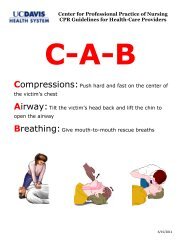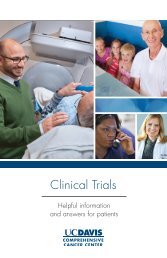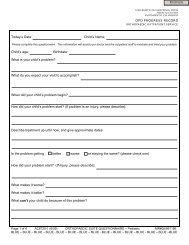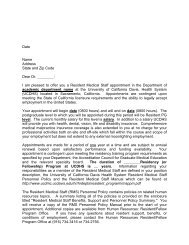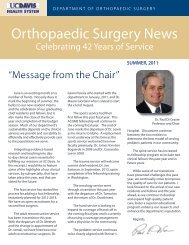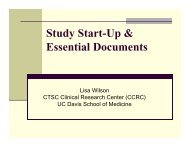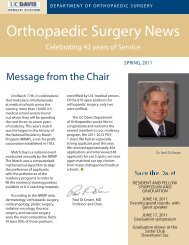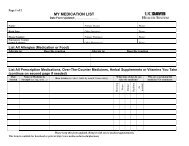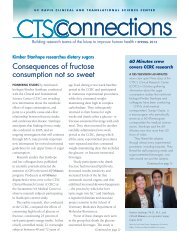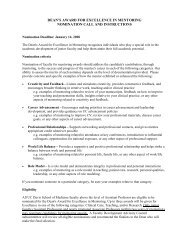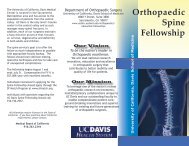Resident Handbook - UC Davis Health System
Resident Handbook - UC Davis Health System
Resident Handbook - UC Davis Health System
- No tags were found...
Create successful ePaper yourself
Turn your PDF publications into a flip-book with our unique Google optimized e-Paper software.
o Schedule II drugs may be written for terminal patients using standardprescription pads if the physician writes on the prescription “11159.2Exemption”• Schedule III and IV drugs:oThese drugs may be written by a licensed resident or attending physician using his/herDEA number and the controlled substance prescription pad specific for that physician.Alternatively, a schedule III or IV prescription may be written using a standardprescription if it is faxed or called into the retail pharmacy by telephone, using theprescriber’s DEA number.• <strong>Resident</strong>s must be licensed and have a DEA number to write for controlledsubstances.Outpatient: When unlicensed residents write outpatient prescriptions, the prescription must beco-signed by the preceptor. Licensed residents do not need co-signatures. Prescriptions forcontrolled substances can only be written and signed by a licensed physician using his/her“triplicate” form.Helpful Hints to reduce medication errors:Include patients name and date of birth on all prescriptionsCreate a clear, consistent and standard way for you to write every prescription. For in-patients, this couldbe: Drug, Strength, Form, Route, Frequency, Duration. Example: Amoxicillin 250mg/tab, One tab p.o.q6h X 7days.An out-patient prescription should also indicate the number to dispense and refills. Example: Amoxicillin250 mg tabs. Disp #28. Sig: One tab po q6h X 7 days. No Refill.Develop pre-printed medication orders, where possible, listing the most commonly prescribed drugs withselected dosages, frequencies for administration, and times of administration.Refrain from using abbreviations such as:“u” for units, “iu” for international units“pen” for penicillin,“QD” for daily, “QID” for 4 times daily, “QOD” for every other day,“MS” for Morphine Sulfate, “MSO4” for Magnesium Sulfate,or apothecary symbols for drams, minims, or ounces. These words should be written out instead.Write “ml” not “cc”Eliminate the use of “trailing zero’s” – use 2mg instead of 2.0mg (easily mistaken for 20mg). Always use“leading zero’s” – use 0.125 rather than .125.Order medications by “mcg,” “mg,” or “g” strength when possible. Example: Tylenol 650 mg instead ofTylenol 2 tabs (Tylenol comes in different strengths).Be aware of potential look-alike and sound-alike drugsDo not write “Resume previous orders.”When in house, write the order, don’t make it a verbal order to the nurse on the floor. Don’t give phoneorders whenever possible.Print your name for each order, with beeper #. Write clearly!!!Page 103 of 153PROCEDURE COMPETENCYThe program uses a method by which all procedures will be supervised and evaluated and kept inan online database called New Innovations. The program has devised a credentialing process toC:\Documents and Settings\dhutak\Desktop\rshb13.doc




